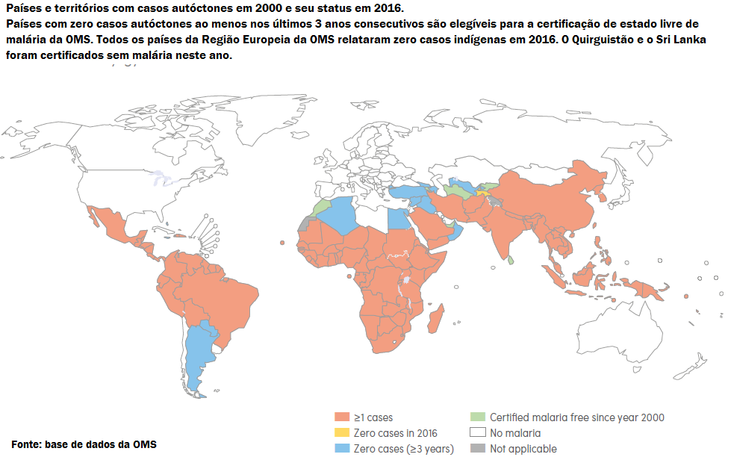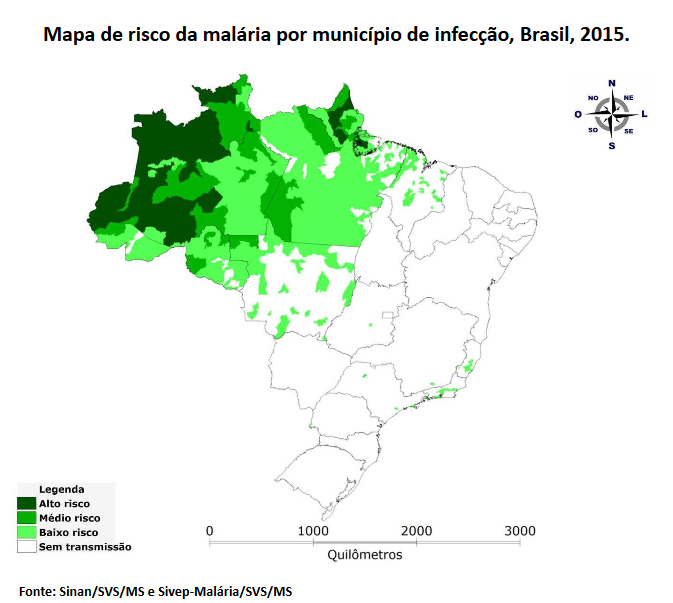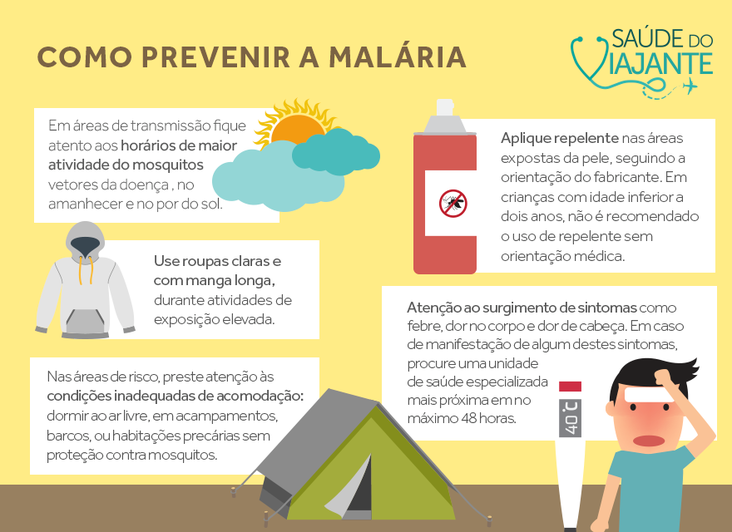Malaria
THE DISEASE IN THE WORLD
The percentage of populations at risk in Africa with malaria parasite infections fell from 17% in 2010 to 13% in 2015. In this region, the number of people infected declined from 131 million in 2010 to 114 million in 2015. Worldwide , 212 million malaria cases were recorded in 2015. Most of them in the African Region (90%), followed by Southeast Asia (7%) and Eastern Mediterranean (2%).
The disease incidence rate declined 41% between 2000 and 2015, and 21% between 2010 and 2015.
Of the 91 countries and territories with disease transmission in 2015, it is estimated that 40 have achieved a reduction in incidence rates of 40% or more between 2010 and 2015 and can be considered to be in the process of achieving the overall reduction target of 40% by 2020.
However, a new epidemiological update by the Pan American Health Organization (PAHO), issued on January 30, 2018, recommends that countries in the Americas strengthen surveillance and control actions for malaria following an increase in the number of cases in several countries in 2016 and 2017.
The recommendation comes after nearly a decade (2005-2014) of sustained decline in the number of malaria cases in the region. Nine countries (Colombia, Ecuador, El Salvador, Haiti, Honduras, Nicaragua, Panama and Venezuela) reported an increase in cases in 2016. Last year five countries (Brazil, Ecuador, Mexico, Nicaragua and Venezuela) also reported a cases of the disease.
PAHO warns that achievements in eliminating the disease can be compromised if surveillance and control actions throughout the region are not maintained or strengthened.
The existence of conditions of vulnerability and poverty in populations inhabiting areas with vector presence and disease transmission - and the predominance of labor and economic activities that increase the risk of exposure to vectors (mining, extraction of natural products, agriculture) such as the unplanned occupation of space - are some of the determinants that explain the increase in cases. The mobile and migrant populations are particularly vulnerable groups due to housing conditions and the lack of social protection.
WHO certifies Paraguay malaria-free
The World Health Organization (WHO) on Monday certified Paraguay as having eliminated malaria. It is the first country in the Americas to obtain this status from Cuba in 1973.
In 2016, WHO identified Paraguay as one of 21 countries with the potential to eliminate malaria by 2020. Through the “E-2020 initiative,” WHO is supporting these countries as they scale up activities to become malaria-free. Other E-2020 countries in the Americas include Belize, Costa Rica, Ecuador, El Salvador, Mexico and Suriname.
From 1950 to 2011, Paraguay systematically developed policies and programmes to control and eliminate malaria, a significant public health challenge for a country that reported more than 80 000 cases of the disease in the 1940s. As a result, Paraguay registered its last case of Plasmodium falciparum malaria in 1995, and P. vivax malaria in 2011.
A five-year plan to consolidate the gains, prevent re-establishment of transmission and prepare for elimination certification was launched in 2011. Activities focused on robust case management, engagement with communities, and education to make people more aware of ways to prevent malaria transmission, and about diagnosis and treatment options.
In 2016, in the next phase of the elimination drive, the Ministry of Health launched a three-year initiative to build Paraguay’s front-line health workers’ skills. Backed by The Global Fund to Fight AIDS, Tuberculosis and Malaria, the country strengthened its capacity to prevent disease, identify suspected malaria cases, accurately diagnose malaria and provide prompt treatment – key strategies to tackle the on-going threat of malaria importation from endemic countries elsewhere in the Americas and sub-Saharan Africa.In April 2018, the independent Malaria Elimination Certification Panel concluded that Paraguay had interrupted indigenous malaria transmission for the requisite 3 years and had the capacity to prevent the re-establishment of transmission. The Panel recommended the WHO Director-General certify the country malaria-free.
In April 2018, the independent Malaria Elimination Certification Panel concluded that Paraguay had interrupted indigenous malaria transmission for the requisite 3 years and had the capacity to prevent the re-establishment of transmission. The Panel recommended the WHO Director-General certify the country malaria-free.
SITUATION IN BRAZIL
A new epidemiological update by the Pan American Health Organization (PAHO) reveals that malaria is advancing in the Amazon region of Brazil. In 2016, the country recorded 117,832 cases of the disease in nine states. In 2017, the number reached 174,522, wich represents an increase of 48%.
The most affected federal unit is Amazonas, with about 74 thousand occurrences of the pathology last year. In 2016, there were approximately 45 thousand cases. The second state with the highest number of infections was Pará - about 33,000 in 2017, well above the 13,000 identified in 2016. Acre reported about 32,000 cases in 2017, a significant volume but not indicating very large variation in relation to the 31 thousand cases of 2016.
Tocantins, although it had the lowest number of cases (71), was the state with the largest increase (223%) compared to 2016, when only 22 cases were recorded.
The trends in the Amazon region accompany the expansion of malaria in the Americas identified by PAHO in its epidemiological update. In 2016, nine countries - Colombia, Ecuador, El Salvador, Haiti, Honduras, Nicaragua, Panama and Venezuela - reported an increase in cases of the disease. Last year, in addition to Brazil, Ecuador, Mexico, Nicaragua and Venezuela also reported an increase in the number of infections.
Given the current scenario, PAHO recommends that countries in the Americas strengthen surveillance and control actions for malaria and warns that achievements in eliminating malaria can be compromised if these actions do not take effect. In early 2017, PAHO warned its Member States about the risk of outbreaks, increased cases and deaths in areas where the disease is endemic. The institution also called attention to the possible reappearance of the pathology in areas where transmission had already been interrupted.
Conditions of vulnerability and poverty are some of the factors that explain the current progress of malaria. The UN agency stresses that certain labor and economic activities, such as mining, extraction of natural products and agriculture, increase the risk of exposure of populations to vectors in areas with transmission of the disease.
PAHO also points out that migrant populations are particularly vulnerable groups due to housing conditions and lack of social protection.
List of municipalities belonging to areas at risk or endemic for malaria.
RECOMMENDATIONS
Countries are encouraged to strengthen surveillance and disease control measures, especially measures related to early case detection, timely diagnosis and immediate treatment initiation.
The main action to control the transmission of malaria is to reduce the delay between the onset of symptoms and the treatment of the case, as well as carry out timely investigation and response to cases.
PAHO also suggests that the diagnosis and complete treatment with antimalarials be taken closer to the communities at risk, request complementary vector control interventions, assure the quality of the parasitological diagnosis and avoid the lack of medication.
Access the epidemiological update of PAHO.





